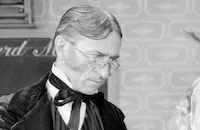Sing Neighbor Sing
Cast & Crew
Frank Mcdonald
Roy Acuff
Lulubelle
Scotty
Harry "pappy" Cheshire
The Milo Twins
Film Details
Technical Specs

Synopsis
Enterprising young Bob Reed and his friends, Scotty, Roy and Roy's band, perform on a radio show sponsored by barber Joe. Although Joe likes the musical portion of the show, he loathes Bob's act, in which he poses as an advice-giving psychologist. Bob, who wears a fake beard during the act, explains to Joe that he based the character on a famous English psychologist, Professor Jasper Cartwright, and that he can make a lot of money by selling pamphlets of his advice. Joe is fed up, however, and fires the boys, after which they leave for California. While traveling, the boys encounter students Virginia Blake, Lulubelle and their friends as they return to Blake College. Although Bob is immediately attracted to Virginia, his overbearing attempts at romance annoy her and she strands him in a bull's pasture. Later that afternoon, the hungry boys pass by a hotel run by the students at the college, and Bob dons his disguise to obtain food. His plan backfires when the intellectual Lulubelle "recognizes" him as Professor Cartwright. She introduces him to the school's dean, Professor Harry "Pappy" Cheshire, who seconds Lulubelle's request that Bob give a lecture. Meanwhile, Roy, Scotty and the boys invite themselves in for supper by stating that they want to attend the college. Bob tries to decline the invitation to lecture, but changes his mind when Virginia arrives with her aunt, crabby Cornelia Blake, who founded the college but now wants to close it due to economic straits. During Bob's lecture, he is forced to hypnotize Cornelia, and thereby reveals that the source of her bad humor is an unfulfilled passion for Professor Cheshire, who was her teenage sweetheart. In order to pursue Virginia, Bob agrees to stay and give more lectures, to be broadcast on the local radio station, but pacifies Roy and the boys with the promise that they will make a fortune by selling chapters of the real Cartwright's books. As time passes, the pamphlets sell rapidly, and as himself, Bob courts Virginia. One afternoon, Bob is stunned when Virginia tells him how much "Professor Cartwright" has helped the locals with his advice, and he begins to feel badly about having deceived her and Pappy. Bob reveals the truth to Pappy, who agrees that he must leave after the upcoming college party. At the party, Bob, Virginia and their pals have a good time, and even Cornelia relaxes enough to settle her ancient quarrel with Pappy. The older couple are reconciled and all appears to be going well until the appearance of the real Cartwright, who was traveling through the area and read a newspaper account of "his" help to the townspeople. Bob, who is not aware of the professor's arrival, dons his disguise for his last broadcast and goes to the auditorium. There, one of the girls sees the two Cartwrights and Bob rushes out. He is forced to tell Virginia the truth, but she is not angry, and the couple embrace. All is resolved when the real professor decides to stay and continue Bob's good works, while Bob stays to manage the radio station, on which Roy and the others will perform.

Director
Frank Mcdonald
Cast
Roy Acuff
Lulubelle
Scotty
Harry "pappy" Cheshire
The Milo Twins
Carolina Cotton
Brad Taylor
Ruth Terry
Virginia Brissac
Beverly Loyd

Charles Irwin

Olin Howlin
Maxine Doyle
Mary Kenyon
Florence Pepper
Earle Hodgins
Joyce Elaine
Ben Erway
Crew
Roy Acuff
Adele
Donald H. Brown
Dale Butts
Gano Chittenden
Earl Crain Sr.
Frank Crumit
Billie Curtis
Ralph Dixon
Jack Elliott
Kenneth Holmes
Jerry Jarrette
Reggie Lanning
Johnny Marvin
Dorrell Mcgowan
Stuart Mcgowan
Edward Milo
Edwin Milo
George Milo
Fred Rose
Armand Schaefer
Morton Scott
Scotty Wiseman

Film Details
Technical Specs

Quotes
Trivia
Notes
Contemporary sources frequently list this film's title as Sing, Neighbor, Sing, but the title on the viewed print contained no punctuation. According to the CBCS and the studio official billing sheet, actor Brad Taylor replaced Stanley Brown in the role of "Bob Reed." The Daily Variety review erroneously credits Russ Kimball as the film's art director.












